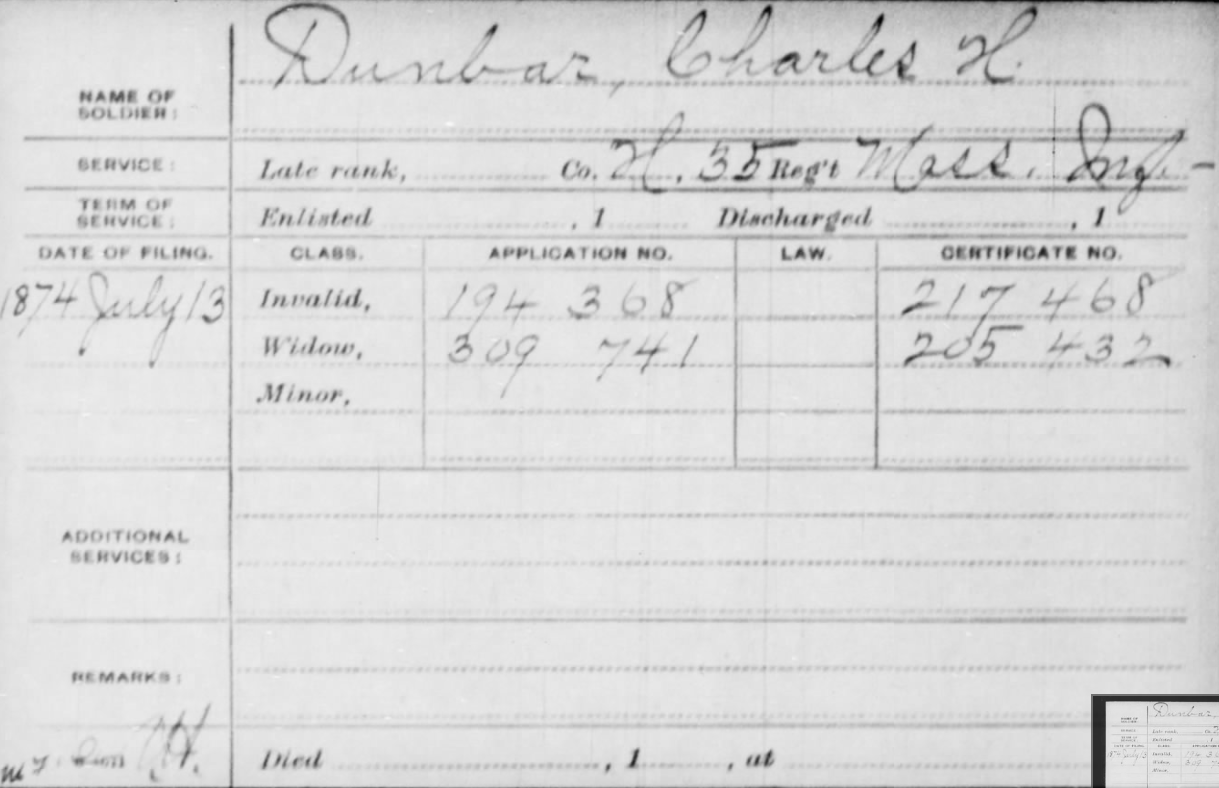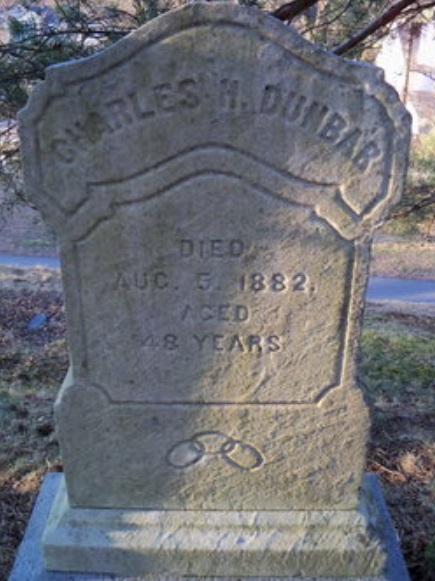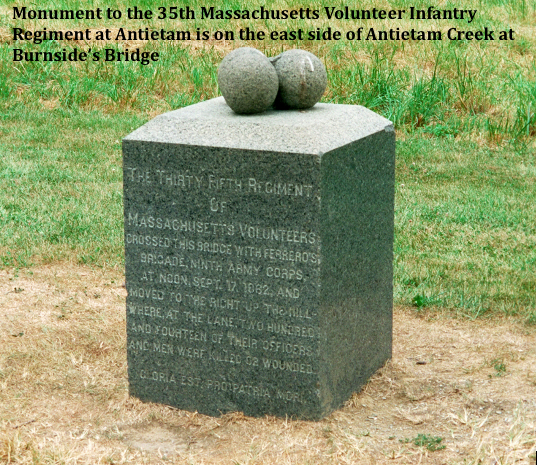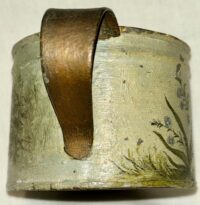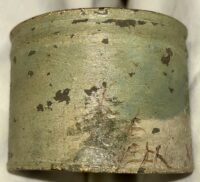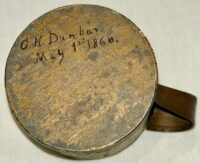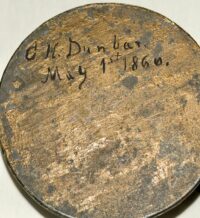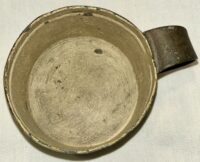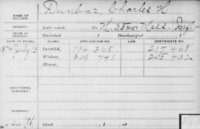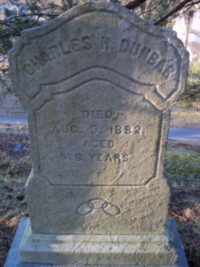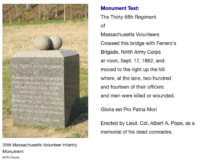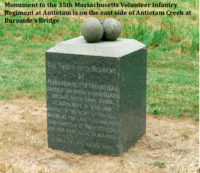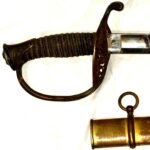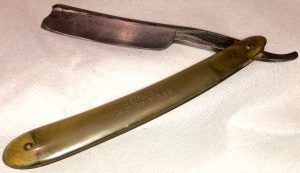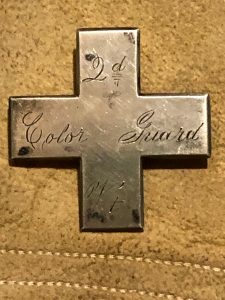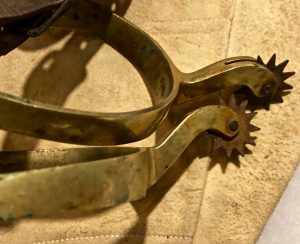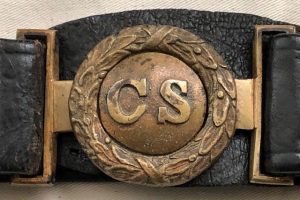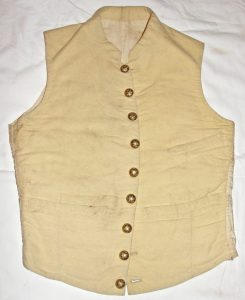Id’d Civil War Period Tin Cup with Veteran Painted Winter Scene – Lt. Charles H. Dunbar Co. H 35th Mass. Infantry
SOLD
Id’d Civil War Period Tin Cup with Veteran Painted Winter Scene – Lt. Charles H. Dunbar Co. H 35th Mass. Infantry – This relatively small, soldered, tin cup was seemingly, artfully embellished by Lt. Charles H. Dunbar, shortly after the war. In all likelihood, this cup was Dunbar’s during his time in the 35th Massachusetts Infantry; we have encountered many soldier’s personal, war period items, painted, after the war, thereby commemorating their service. Lt. Dunbar painted or inked, on the bottom of the cup, the following:
“C.H. Dunbar
May 1st 1866”
Charles H. Dunbar enlisted in August, 1862 into Co. H of the 35th Massachusetts Infantry. During the Battle of Antietam, on September 17, 1862, Dunbar was listed as missing. He would return safely to his regiment, only to be wounded at the Battle of Fredericksburg, on December 13, 1862. Dunbar again returned to his regiment and was promoted to the rank of 1st Lieutenant, in January, 1863. Dunbar remained with the 35th Mass. until being discharged for disability, in June, 1864. Interestingly, Dunbar was employed as a house painter, after the war. During Lt. Dunbar’s service, his regiment would participate in numerous engagements to include: the Battles of South Mountain, Antietam, Fredericksburg, the Siege of Vicksburg, the Knoxville Campaign, the Wilderness, Spotsylvania, North Anna and Totopotomoy. The cup remains in very good condition, with some minor areas of paint loss, in the winter scene.
Measurements: H – 2”; Diameter – 3”
Charles H. Dunbar
| Residence Weymouth MA; a 27-year-old House Painter.
Enlisted on 8/8/1862 as a Sergeant. On 8/19/1862 he mustered into “H” Co. MA 35th Infantry He was discharged for disability on 6/17/1864. He was listed as: * Missing 9/17/1862 Antietam, MD * Wounded 12/13/1862 Fredericksburg, VA Promotions: * 2nd Lieut * 1st Lieut 1/17/1863 Other Information: Member of GAR Post # 58 (Reynolds) in Weymouth, MA died 8/4/1882 After the War he lived in East Weymouth, MA |
Charles H Dunbar
| Name | Charles H Dunbar |
| Enlistment Age | 27 |
| Birth Date | abt 1835 |
| Enlistment Date | 8 Aug 1862 |
| Enlistment Rank | Sergeant |
| Muster Date | 19 Aug 1862 |
| Muster Place | Massachusetts |
| Muster Company | H |
| Muster Regiment | 35th Infantry |
| Muster Regiment Type | Infantry |
| Muster Information | Enlisted |
| Rank Change Rank | 2nd Lieutenant |
| Casualty Date | 13 Dec 1862 |
| Casualty Place | Fredericksburg, Virginia |
| Type of Casualty | Wounded |
| Muster Out Date | 17 Jun 1864 |
| Muster Out Information | disch disability |
| Side of War | Union |
| Survived War? | Yes |
| Was Officer? | Yes |
| Injured in Line of Duty? | Yes |
| Residence Place | Weymouth, Massachusetts |
| Last Known Residence Place | East Weymouth, Massachusetts |
| Death Date | 4 Aug 1882 |
| Occupation | House Painter |
| Notes | 1862-09-17 Missing, (Antietam, MD) |
| Additional Notes 2 | Rank Change 2 Date: 17 Jan 1863; Rank Change 2 Rank: First Lieutenant; |
Charles Henry Dunbar VVETERAN
BIRTH
30 Jul 1834
Hingham, Plymouth County, Massachusetts, USA
DEATH
5 Aug 1882 (aged 48)
Hingham, Plymouth County, Massachusetts, USA
BURIAL
Hingham, Plymouth County, Massachusetts, USA
Son of Hosea Dunbar and Lucy Wilder. Husband of Lovinia I. Scribner, married 05 July 1857. Father of:
* Charles Dexter Dunbar b 1858
* Frank Merton Dunbar 1860–1903
* Herbert Wallace Dunbar b 1867
* Jennie Wilder Dunbar 1872–1904
* Arthur Peakes Dunbar 1873–1923
* Alice Goodwin Dunbar b 1876
His military record listed his residence as Weymouth, Mass, his occupation as a house painter, and his age at enlistment as 27. His enlistment date was 8 Aug 1862, and was listed a Sergeant, Company H, Massachusetts 35th Infantry Regiment on 19 Aug 1862. He was wounded, promoted to Full 2nd Lieutenant and to Full 1st Lieutenant on 17 Jan 1863, finally mustered out on 17 Jun 1864.
35th MA Infantry
( 3-years )
| Organized: Camp Stanton, Lynnfield, MA on 8/1/62 Mustered Out: 6/9/65 at Alexandria, VAOfficers Killed or Mortally Wounded: 10 Officers Died of Disease, Accidents, etc.: 1 Enlisted Men Killed or Mortally Wounded: 138 Enlisted Men Died of Disease, Accidents, etc.: 100 (Source: Fox, Regimental Losses) |
| From | To | Brigade | Division | Corps | Army | Comment |
| Aug ’62 | Sep ’62 | Whipple’s Command | Military District of Washington | |||
| Sep ’62 | Mar ’63 | 2 | 2 | 9 | Army of Potomac | |
| Mar ’63 | Jun ’63 | 2 | 2 | 9 | Army and Dept of Ohio | |
| Jun ’63 | Aug ’63 | 2 | 2 | 9 | Department of the Tennessee | |
| Aug ’63 | Apr ’64 | 2 | 2 | 9 | Army and Dept of Ohio | |
| Apr ’64 | May ’64 | 1 | 1 | 9 | Army of Potomac | |
| May ’64 | Jul ’64 | Engineer | 1 | 9 | Army of Potomac | |
| Jul ’64 | Sep ’64 | 1 | 1 | 9 | Army of Potomac | |
| Sep ’64 | Jun ’65 | 1 | 2 | 9 | Army of Potomac | Mustered Out |
THIRTY-FIFTH REGIMENT
MASSACHUSETTS VOLUNTEER INFANTRY
THREE YEARS
| The 35th Regt. Mass. Vol. Inf. was organized at Camp
Stanton, Lynnfield, and was composed mostly of men enrolled in eastern Massachusetts. It was recruited during July and the early part of August, 1862, and its members were mustered into the service largely between August 9 and 19. Under Col. Edward A. Wild the regiment left for the seat of war August 22, reaching B. Washington on the 24th. On Sept. 8, it was assigned to Ferrero’s (2d) Brigade, Sturgis’ (2d) Division, Reno’s (9th) Corps. Joining the Army of the Potomac it took part in the battle of South Mountain, Sept. 14, 1862, where Col. Wild lost his left arm. At Antietam, Sept. 17, under command of Lieut. Col. Carruth, the regiment lost 214 officers and men, of whom 69 were killed or mortally wounded. At Fredericksburg, Dec. 13, 1862, it again suffered severely, losing Major Willard, who was in command. It camped during the early part of the winter near Falmouth.
On Feb. 9, 1863, it was transferred to Newport News, Va., and, after a few weeks stay at this place, was sent with the 9th Corps into Kentucky, being stationed at Mount Stirling, Lancaster, Stanford, and other places. Lieut. Col. Carruth now became colonel of the regiment. It was next ordered to Vicksburg, Miss., to reinforce Gen. Grant, remaining about four weeks, until the surrender of the city, July 4. It participated in the pursuit of Johnston’s army to Jackson, Miss., and was present at the capture of the city, then returned to its old camp near Vicksburg. From here it proceeded by boat and train to Cincinnati, reaching there the 14th of August.
Proceeding to Knoxville, Tenn., which it reached Oct. 22, it participated in the defense of the city against Longstreet. After the close of the siege, Dec. 4, the 35th soon proceeded to Blain’s Cross Roads, where it remained, enduring great privations, until January, 1864. After various movements -to Knoxville, Morristown, and elsewhere- the regiment returned to Cincinnati. Here, April 1, it entrained for Baltimore, Md., from whence it took boat for Annapolis.
In the reorganization of the 9th Corps the regiment, now commanded by Major Nat Wales, became a part of Carruth’s (1st) Brigade, Stevenson’s (1st) Division. During the battle of the Wilderness, May 5 and 6, and the first part of that of Spottsylvania, May 8 to 12, the 35th was in charge of the supply train of the 1st Division, and was not engaged. Returning to its brigade, May 17, on the following day it was in the last assault on the Confederate lines at Spottsylvania, moving thence to the North Anna River, where it was again engaged, May 25.
It was now detailed as an engineer corps for the 1st Division. At Cold Harbor, June 3, it was posted near Bethesda Church and suffered light loss. Crossing the James on June 15, the regiment participated in the siege of Petersburg. At the Crater fight, July 30, it was heavily engaged, losing 12 killed and 34 wounded. At Weldon Railroad, Aug. 19, it was again engaged with loss. It was now reduced to two officers and about 100 men present for duty. In another reorganization of the 9th Corps early in September it was assigned to Curtin’s (1st) Brigade, Potter’s (2d) Division. About this time there were added to the regiment 385 German and French substitutes, recently arrived in this country and ignorant of the English tongue. Major Hudson now commanded the regiment. At Poplar Spring Church, Sept. 30, it was severely engaged, losing 163 prisoners. For two months it was now posted near Forts Fisher and Welsh. During the midwinter it was stationed in the rear of Fort Sedgwick (Fort Hell). From March 7, 1865, until the fall of Petersburg, April 2, it formed a part of the garrison of this fort. It then joined in the pursuit of Lee’s army and was at Farmville when the news came of the surrender.
Arriving at Alexandria, Va., April 28, it remained as a part of the garrison of the District of Columbia until June 9, when it transferred its recruits to the 29th Regiment and was mustered out of the service. Returning to Readville, Mass., on June 27, the men were paid off and discharged. |
35th Regiment, Massachusetts Infantry
OVERVIEW:
Organized at Lynnfield August 1, 1862. Left State for Washington, D. C., August 22. Attached to 2nd Brigade, 2nd Division, 9th Army Corps, Army of the Potomac, to April, 1863; Dept. of the Ohio to June, 1863; Army of the Tennessee to August, 1863, and Dept. of the Ohio to April, 1864. 1st Brigade, 1st Division, 9th Army Corps, Army of the Potomac, to May, 1864. Acting Engineers, 1st Division, 9th Army Corps, to July, 1864. 1st Brigade, 1st Division, 9th Army Corps, to September, 1864. 1st Brigade, 2nd Division, 9th Army Corps, to June, 1865.
SERVICE:
-March into Maryland September 6-12, 1862. Battles of South Mountain, Md., September 14, and Antietam September 16-17. Duty at Pleasant Valley till October 27. Movement to Falmouth, Va., October 27-November 19. Warrenton, Sulphur Springs, November 15. Battle of Fredericksburg December 12-15. “Mud March” January 20-24, 1863. At Falmouth till February 19. Moved to Newport News, Va., February 19, thence to Covington, Ky., March 26-30. Moved to Paris April 1, and to Mt. Sterling April 3. To Lancaster May 6-7, thence to Crab Orchard May 23, and to Stanford May 25. Movement to Vicksburg, Miss., June 3-14. Siege of Vicksburg June 14-July 4. Advance on Jackson, Miss., July 5-10. Siege of Jackson July 10-17. At Milldale till August 6. Moved to Cincinnati, Ohio, August 6-14. At Covington, Ky., till August 18. March to Nicholasville August 18-25, and to Crab Orchard September 9-11. March over Cumberland Mountains to Knoxville, Tenn., thence to Lenoir Station October 2-29. Knoxville Campaign November 4-December 23. At Lenoir Station till November 14. Campbell’s Station November 16. Siege of Knoxville November 17-December 4. Pursuit of Longstreet December 5-19. Operations in East Tennessee till March 20, 1864. Movement to Annapolis, Md., March 20-April 7. Rapidan Campaign May-June. Battles of the Wilderness May 5-7; Spottsylvania May 8-12; Ny River May 10; Spottsylvania C. H. May 12-21. Assault on the Salient May 12. North Anna River May 23-26. On line of the Pamunkey May 26-28. Totopotomoy May 28-31. Cold Harbor June 1-12. Bethesda Church June 1-3. Before Petersburg June 16-18. Siege of Petersburg June 16, 1864, to April 2, 1865. Mine Explosion, Petersburg, July 30, 1864. Weldon Railroad August 18-21. Peebles’ Farm September 29-October 2. Boydton Plank Road, Hatcher’s Run, October 27-28. Fort Stedman March 25, 1865. Appomattox Campaign March 28-April 9. Assault on and fall of Petersburg April 2. Occupation of Petersburg April 3. March to Cumberland Church April 4-10. Moved to City Point, thence to Alexandria April 20-28. Grand Review May 23. Mustered out June 9, and discharged from service June 27, 1865.
Regiment lost during service 10 Officers and 138 Enlisted men killed and mortally wounded and 1 Officer and 100 Enllsted men by disease. Total 249.
35th Regiment Massachusetts Volunteer Infantry
Three Years
|
|
Regimental history from Massachusetts Soldiers, Sailors, and Marines in the Civil War, compiled and published by the Adjutant General:
Regimental history from A Compendium of the War of the Rebellion, by Frederick Dyer:Organized at Worcester August 1, 1862. Left State for Washington, D.C., August 22. Attached to 2nd Brigade, 2nd Division, 9th Army Corps, Army of the Potomac, to April, 1863; Dept. of the Ohio to June, 1863; Amy of the Tennessee to August, 1863, and Dept. of the Ohio to April, 1864. 1st Brigade, 1st Division, 9th Army Corps, Army of the Potomac, to May, 1864. Acting Engineers, 1st Division, 9th Army Corps, to July, 1864. 1st Brigade, 1st Division, 9th Army Corps, to September, 1864. 1st Brigade, 2nd Division, 9th Army Corps, to June, 1865. March into Maryland September 6-12, 1862. Battles of South Mountain, Md., September 14, and Antietam September 16-17. Duty at Pleasant Valley until October 27. Movement to Falmouth, Va., October 27-November 19. Warrenton, Sulphur Springs, November 15. Battle of Fredericksburg December 12-15. “Mud March” January 20-24, 1863. At Falmouth until February 19. Moved to Newport News, Va., February 19, thence to Covington, Ky., March 26-30. Moved to Paris April 1, and to Mr. Sterling April 3. To Lancaster May 6-7, thence to Crab Orchard May 23, and to Stanford May 25. Movement to Vicksburg, Miss., June 3-14. Siege of Vicksburg June 14-July 4. Advance on Jackson, Miss., July 5-10. Siege of Jackson July 10-17. At Milldale until August 6. Moved to Cincinnati, Ohio, August 6-14. At Covington, Ky., until August 18. March to Nicholasville August 18-25, and to Crab Orchard September 9-11. March over Cumberland Mountains to Knoxville, Tenn., thence to Lenoir Station October 2-29. Knoxville Campaign November 4-December 23. At Lenoir Station until November 14. Campbell’s Station November 16. Siege of Knoxville November 17-December 4. Pursuit of Longstreet December 5-19. Operations in East Tennessee until March 20, 1864. Movement to Annapolis, Md., March 20-April 7. Rapidan Campaign May-June. Battles of the Wilderness May 5-7; Spottsylvania May 8-12; Ny River May 10; Spottsylvania C. H. May 12-21. Assault on the Salient May 12. North Anna River May 23-26. On line of the Pamunkey May 26-28. Totopotomoy May 28-31. Cold Harbor June 1-12. Bethesda Church June 1-3. Before Petersburg June 16-18. Siege of Petersburg June 16, 1864, to April 2, 1865. Mine Explosion, Petersburg, July 30, 1864. Weldon Railroad August 18-21. Poplar Springs Church September 29-October 2. Boydton Plank Road, Hatcher’s Run, October 27-28. Fort Stedman March 25, 1865. Appomattox Campaign March 28-April 9. Assault on and fall of Petersburg April 2. Occupation of Petersburg April 3. March to Farmville April 4-10. Moved to City Point, thence to Alexandria April 20-28, Grand Review May 23. Mustered out June 9, and discharged from service June 27, 1865. Regiment lost during service 10 Officers and 138 Enlisted men killed and mortally wounded and 1 Officer and 100 Enlisted men by disease. Total 249. |
35th Massachusetts Infantry Regiment
| 35th Massachusetts Volunteer Infantry | |
| Active | August 1, 1862 to June 27, 1865 |
| Country | United States |
| Allegiance | Union |
| Branch | Infantry |
| Size | 1,496 |
| Engagements | Battle of South Mountain Battle of Antietam Battle of Fredericksburg Siege of Vicksburg Siege of Jackson Knoxville Campaign Rapidan Campaign Battle of the Wilderness Battle of Spotsylvania Court House Battle of North Anna Battle of Totopotomoy Creek Battle of Cold Harbor Siege of Petersburg Battle of the Crater Battle of Globe Tavern Battle of Boydton Plank Road Battle of Fort Stedman Appomattox Campaign Third Battle of Petersburg |
The 35th Massachusetts was an infantry regiment that served in the Union Army during the American Civil War.
Service
The 35th Massachusetts was organized at Boston and Chelsea, Massachusetts, trained at Camp Stanton from August 1–22, 1862, and mustered in for three-year service on August 28, 1862 under the command of Colonel Edward A. Wild.
The regiment was attached to 2nd Brigade, 2nd Division, IX Corps, Army of the Potomac, to April 1863. Department of the Ohio to June 1863. Army of the Tennessee to August 1863, and Department of the Ohio to April 1864. 1st Brigade, 1st Division, IX Corps, Army of the Potomac, to May 1864. Acting Engineers, 1st Division, IX Corps, to July 1864. 1st Brigade, 1st Division, IX Corps, to September 1864. 1st Brigade, 2nd Division, IX Corps, to June 1865.
The 35th Massachusetts mustered out of service on June 9, 1865 and was discharged June 27, 1865.
Company
Main article: Dedham, Massachusetts in the American Civil War
The results of the Peninsular campaign revealed the necessity of replenishing the army.[1] In early in July 1862, the President had called for 300,000 men for three years and assigned the quota of Massachusetts at 15,000 men.[2] The quota of Dedham, Massachusetts was 69 and the Selectmen, through whom thenceforward all recruiting during the war was carried on, issued their call for that number.[2] On July 21, the town voted to pay a bounty of $100 to each volunteer with aid to families.[2] It also appropriated $6,900 for the bounties.[2]
One of the largest and most impressive of the public meetings during the war was held July 10, before the legal town meeting.[3] Men were there inspired by an earnest purpose to devote themselves to the country.[3] After the preliminary discussion as to bounties, the roll was opened and then came a pause when it seemed doubtful if any would come forward.[3] The first man to sign that roll was the father of Joseph Jordan, the private who had been killed at Gaines Mills.[3] Another was a young man who had been recently graduated at the University and was beginning his professional studies.[3] A third announced his purpose in impressive and earnest words.[3] He would later receive a severe wound in battle and then nearly a year’s confinement in four rebel prisons.[3] The quota was soon filled.[3]
Uniting with men from Needham and Weston, the new recruits constituted Company I of the 35th Massachusetts Infantry Regiment.[3] Without any opportunities for drill or organization, the regiment left the state on August 22, 1862 for the seat of war.[3] On their arrival at Washington, they were immediately assigned to the defenses of the city in throwing up earthworks and doing picket duty.[3]
Detailed service
Left Massachusetts for Washington, D.C., August 22. Marched into Maryland September 6–12, 1862. Battle of South Mountain, Md., September 14. Battle of Antietam September 16–17. Duty at Pleasant Valley until October 27. Movement to Falmouth, Va., October 27-November 19. Warrenton, Sulphur Springs, November 15. Battle of Fredericksburg December 12–15. “Mud March” January 20–24, 1863. At Falmouth until February 19. Moved to Newport News, Va., February 19, then to Covington, Ky., March 26–30. Moved to Paris April 1, and to Mt. Sterling April 3. To Lancaster May 6–7, then to Crab Orchard May 23, and to Stanford May 25. Movement to Vicksburg, Miss., June 3–14. Siege of Vicksburg June 14-July 4. Advance on Jackson, Miss., July 5–10. Siege of Jackson July 10–17. At Milldale until August 6. Moved to Cincinnati, Ohio, August 6–14. At Covington, Ky., until August 18. Marched to Nicholasville August 18–25, and to Crab Orchard September 9–11. Marched over the Cumberland Mountains to Knoxville, Tenn., then to Lenoir Station October 2–29. Knoxville Campaign November 4-December 23. At Lenoir Station until November 14. Campbell’s Station November 16. Siege of Knoxville November 17-December 4. Pursuit of Longstreet December 5–19. Operations in eastern Tennessee until March 20, 1864. Movement to Annapolis, Md., March 20-April 7. Rapidan Campaign May–June. Battle of the Wilderness May 5–7. Spotsylvania May 8–12. Ny River May 10. Spotsylvania Court House May 12–21. Assault on the Salient May 12. North Anna River May 23–26. On line of the Pamunkey May 26–28. Totopotomoy May 28–31. Cold Harbor June 1–12. Bethesda Church June 1–3. Before Petersburg June 16–18. Siege of Petersburg June 16, 1864 to April 2, 1865. Mine Explosion, Petersburg, July 30, 1864. Weldon Railroad August 18–21. Poplar Springs Church September 29-October 2. Boydton Plank Road, Hatcher’s Run, October 27–28. Fort Stedman March 25, 1865. Appomattox Campaign March 28-April 9. Assault on and fall of Petersburg April 2. Occupation of Petersburg April 3. March to Farmville April 4–10. Moved to City Point, then to Alexandria April 20–28. Grand Review of the Armies May 23.
Casualties
The regiment lost a total of 249 men during service; 10 officers and 138 enlisted men killed or mortally wounded, 1 officer and 100 enlisted men died of disease.
Commanders
- Colonel Edward A. Wild – promoted to brigadier generalApril 24, 1863
- Colonel Sumner Carruth
- MajorSidney Willard – commanded at the Battle of Fredericksburg where he was mortally wounded in action
- Major Nathaniel Wales – commanded during the Knoxville Campaign
- CaptainStephen H. Andrews – commanded at the Battle of Fredericksburg after Maj. Willard was mortally wounded in action
- Captain Clifton A. Blanchard – commanded at the Battle of the Crater
Notable members
- SergeantMarcus M. Haskell, Company C – Medal of Honor recipient for action at the Battle of Antietam
- Captain William Sterling King, Company K – future colonel and brevetbrigadier general
- Captain John Lathrop,[4]Company I – associate justice of the Massachusetts Supreme Judicial Court, 1891-1906









